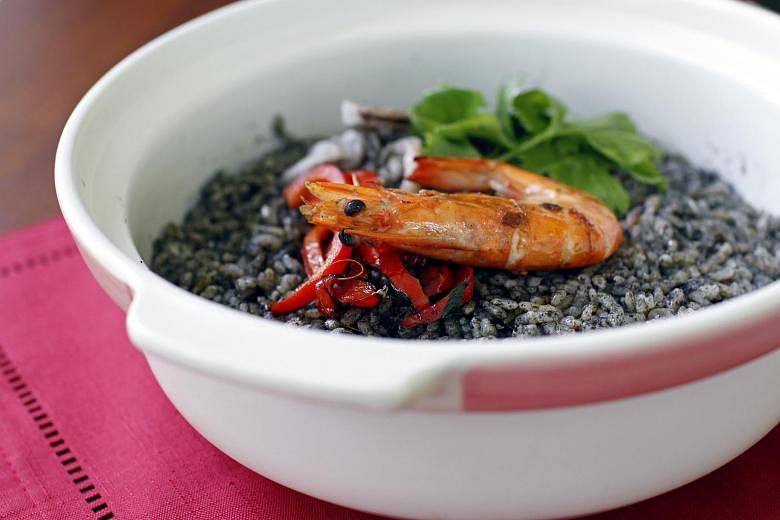You do not need a paella pan to cook paella. This is the Spanish rice dish, which I'm crazy about probably because it is just rice and, usually, seafood.
If I'm homesick for rice when abroad, I look for paella at restaurants. It is so universally popular that you can find it at many restaurants even if they are not Spanish.
But, of course, the Spanish are unparalleled at it, and are particular not only about the rice (short grain, please) but also about the sofrito used for the dish.
This is a flavour base of garlic, onion, paprika, peppers and tomatoes cooked in olive oil.
-
SPANISH CLAYPOT RICE
-
INGREDIENTS
1 onion, peeled and chopped
4 cloves of garlic, peeled and chopped
1 tomato, chopped
2 tsp salt
2 cups short-grain brown rice
2 cups prawn stock
1 tsp saffron threads
1 tsp paprika powder
2 red peppers, seeds and white membranes discarded, cut into strips
3 large squids, beaks and cartilage removed, heads and ink sacs left intact and set aside, bodies cut into rings
8-12 large prawns, left unshelled
1 bunch of parsley, chopped
3 tbs olive oil
METHOD
Heat 2 tbs olive oil in a wok. Brown the chopped onion and garlic. Add the chopped tomato and salt.
Add rice grains and fry until translucent. Add paprika powder and saffron threads and stir well.
Add squid heads and red pepper. Cook until the ink is released and colours the rice evenly.
Transfer rice mixture to a claypot.
Add stock and cook covered, bringing to a simmer.
Add squid rings. Continue to cook undisturbed over a low flame until the stock is totally absorbed.
Taste and adjust the seasoning if needed.
In the meantime, clean the wok, then heat 1 tbs olive oil. Sear the whole prawns until they turn pink.
When the rice is almost ready, place the seared prawns on top and leave to cook further, for about five minutes, covered.
Serve garnished with parsley or Chinese celery, chopped.
SERVES FOUR TO SIX
I decided to cook paella one day because it occurred to me that it is actually a healthy dish, comprising just rice, vegetables and seafood.
And if you use brown rice and up the vegetable component by, say, offering a salad with the meal, this improves the health quotient tremendously.
-
Nutritional value: White rice v brown rice
-
WHITE RICE (100g)
Calories: 140 kcal
Protein: 2.8g
Total fat: 0.5g
Dietary fibre: 0.8g
Sodium: 5mg
Iron: 0.2mg
Unsaturated fats: 0.1g
B vitamins: 0.45mg
BROWN RICE (100g)
Calories: 119 kcal
Protein: 3.1g
Total fat: 0.8g
Dietary fibre: 1.5g
Sodium: 3mg
Iron: 0.4mg
Unsaturated fats: 5g
B vitamins: 2.1mg
While I use squid, which is high in cholesterol, it has little saturated fat and even contains healthy monounsaturated and polyunsaturated fats and no trans fat. If you're watching your cholesterol levels, saturated fats should be no more than 7 per cent of your total calories per day and trans fats reduced.
So, on balance, paella is a relatively healthy dish.
But if you are still intimidated, let me tell you this: If you can cook claypot rice, you can cook paella.
I use the same methods to turn out paella, including using a claypot, just don't tell your Spanish friends about it.
And it turns out perfect, at least to my Chinese taste buds.
While you can find chicken, rabbit and different seafoods in paella, I decided on a squid-ink paella, not least because I had enjoyed it at Spanish restaurant La Ventana in Dempsey Hill, where it came in a shallow pan, crowned with just one perfect prawn.
You would need more than one prawn if cooking for the family.
I sear the prawns separately, ensuring no overcooking, and it is also easier that way to cook the numbers I need. I do not even peel the prawns for it looks more artistic presented whole, feelers and all, on the rice.
That's my excuse, anyway.
You cannot run away, however, from cleaning the squid.
Those who do not know squid anatomy should examine the creature first.
There are two things to discard. The hard beak in the centre of the head that you squeeze out and the cartilage in the body of the squid, a transparent sliver of a soft bone that you pull out.
But do ensure that the ink sac, which lies within the body, is left intact because it will, together with the sofrito, flavour and colour the rice.
The rest is simple: You brown the flavour ingredients in a wok, before adding the rice grains. Then you add the squid heads, the ink sacs and the red pepper, to flavour and colour the rice before adding the squid rings and the prawns.
And do not worry about the rice burning at the bottom of the pot - the Spanish, like the Chinese, love a crispy rice crust!
•Sylvia Tan is a freelance writer and cookbook author. Her previous Eat To Live recipes can be found in two cookbooks, Eat To Live and Taste.

